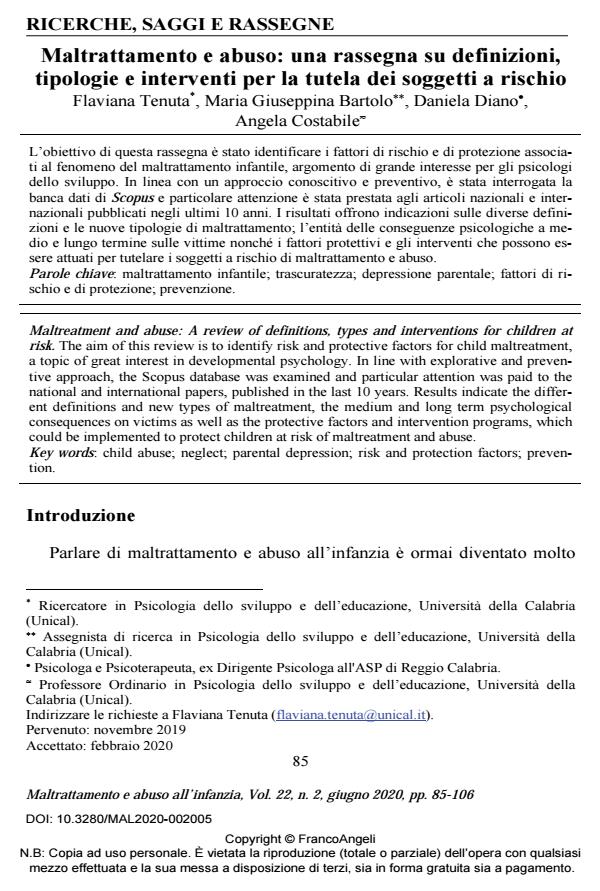Maltreatment and abuse: A review of definitions, types and interventions for children at risk.
Journal title MALTRATTAMENTO E ABUSO ALL’INFANZIA
Author/s Flaviana Tenuta, Maria Giuseppina Bartolo, Daniela Diano, Angela Costabile
Publishing Year 2020 Issue 2020/2
Language Italian Pages 22 P. 85-106 File size 253 KB
DOI 10.3280/MAL2020-002005
DOI is like a bar code for intellectual property: to have more infomation
click here
Below, you can see the article first page
If you want to buy this article in PDF format, you can do it, following the instructions to buy download credits

FrancoAngeli is member of Publishers International Linking Association, Inc (PILA), a not-for-profit association which run the CrossRef service enabling links to and from online scholarly content.
The aim of this review is to identify risk and protective factors for child maltreatment, a topic of great interest in developmental psychology. In line with explorative and preventive approach, the Scopus database was examined and particular attention was paid to the national and international papers, published in the last 10 years. Results indicate the different defini-tions and new types of maltreatment, the medium and long term psychological consequences on victims as well as the protective factors and intervention programs, which could be im-plemented to protect children at risk of maltreatment and abuse.
Keywords: Child abuse; neglect; parental depression; risk and protection factors; prevention.
- Self-esteem and adolescent bullying/cyberbullying and victimization/cybervictimization behaviours: A person-oriented approach Anna L. Palermiti, Maria G. Bartolo, Pasquale Musso, Rocco Servidio, Angela Costabile, in Europe’s Journal of Psychology /2022 pp.249
DOI: 10.5964/ejop.5379 - Incidenza e caratteristiche dei minori accolti in Strutture Residenziali in Regione Lombardia Sarah Miragoli, Ciro Cascone, Francesca Sgrò, Vittoria Badino, Luca Milani, in MALTRATTAMENTO E ABUSO ALL'INFANZIA 3/2024 pp.67
DOI: 10.3280/MAL2023-003005 - Il progetto PEARLS for children in Italia, in Lituania e in Polonia Maura Brandoni, in MALTRATTAMENTO E ABUSO ALL'INFANZIA 1/2023 pp.19
DOI: 10.3280/MAL2023-001003 - TimMi: Ambulatorio per l'intercettazione delle fragilità familiari e la prevenzione del maltrattamento all'infanzia Lucia Romeo, Giusy Soldato, Valeria Brazzoduro, Monica Patrizio, Federica Giannotta, in MALTRATTAMENTO E ABUSO ALL'INFANZIA 1/2021 pp.89
DOI: 10.3280/MAL2021-001006 - Effects of maternal psychological distress and perception of COVID-19 on prenatal attachment in a large sample of Italian pregnant women Francesco Craig, Maria Cecilia Gioia, Vito Muggeo, Juanita Cajiao, Alessia Aloi, Iolanda Martino, Flaviana Tenuta, Antonio Cerasa, Angela Costabile, in Journal of Affective Disorders /2021 pp.665
DOI: 10.1016/j.jad.2021.08.102 - Fattori di rischio e di protezione nella valutazione di famiglie in carico ai Servizi Sociali: uno studio retrospettivo intergenerazionale Martina Cattani, in MALTRATTAMENTO E ABUSO ALL'INFANZIA 2/2022 pp.63
DOI: 10.3280/MAL2022-002005 - Nurse Home Visitation Program per la riduzione del rischio di maltrattamento infantile: una prima valutazione dell'intervento dell'Unità Funzionale Complessa Salute Mentale Infanzia e Adolescenza e Centri Consulenza Giovani dell'Azienda Usl Toscana Centro-Firenze Ludovica Di Paola, Annalaura Nocentini, Patricia Monica Bettini, Roberto Leonetti, in MALTRATTAMENTO E ABUSO ALL'INFANZIA 3/2021 pp.89
DOI: 10.3280/MAL2020-003008
Flaviana Tenuta, Maria Giuseppina Bartolo, Daniela Diano, Angela Costabile, Maltrattamento e abuso: una rassegna su definizioni, tipologie e interventi per la tutela dei soggetti a rischio in "MALTRATTAMENTO E ABUSO ALL’INFANZIA" 2/2020, pp 85-106, DOI: 10.3280/MAL2020-002005